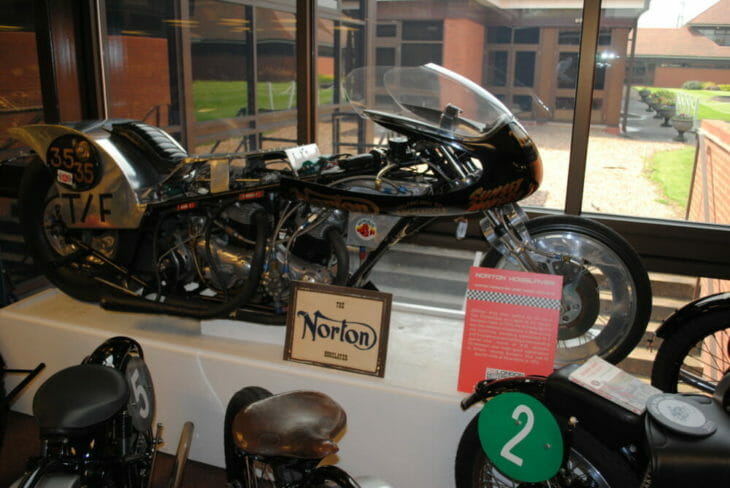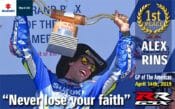Archives: The Hogslayer
“One thing about that bike, anybody’s ever seen it run, never forgot it. It was such a spectacle, what it did and how it did it,” said T.C. Christenson of John Gregory’s diabolical creation, a Norton double-engine drag racer named “The Hogslayer.” Christenson should know, he was the rider of one of the iconic drag racing motorcycles of all-time.
Archives: The Hogslayer

The Hogslayer made stars out of Christenson and Gregory in the drag racing world. Hitting a peak in the early-to-mid-1970s, the nitro burning twin-engine Norton propelled Christenson to four World Championships and helped push the sport of motorcycle drag racing into a golden age during the 1970s.
Lanky and studious, John Gregory started drag racing in the early 1950s out of his hometown of Kenosha, Wisconsin. Gregory was a mechanic at the American Motors factory in Kenosha, but with frequent layoffs, he did a lot of side work and quickly earned a reputation as one of the best mechanics in an area full of top-notch wrench turners. In 1958, Gregory opened a motorcycle shop. It faced west and a popular TV show at the time was called “77 Sunset Strip” so as Gregory recalls “I decided to name the shop Sunset Motors.”
Sunset Motors shop was involved in helping racers in all forms of the sport, from drag racing, to dirt track, scramble and road racing.
T.C. Christenson was a local Kenosha rabble-rouser, who earned a reputation as a wild child as a teen when he and some buddies learned how to make bombs in chemistry class and set one off in front of the police station as a protest to cops giving out tickets to kids for riding their bicycles recklessly. Christenson got into motorcycling at a young age and was doing a lot of street racing. He met Gregory for the first time when he took one of his motorcycles into Gregory’s shop to be worked on.
Christenson and Gregory both shared an interest in drag racing and the two quickly became friends and before long Gregory was helping build drag bikes for Christenson. By the late ‘60s the two were doing so well they decided to form a team and called it Gregory-Christenson Racing.
The first Norton Gregory built for Christenson was a single-engine machine that won a lot of races. Their Norton was fitted with a fuel injection system retrofitted from an Offenhauser car racing engine. In the biggest motorcycle drag meet of 1969, held in Bowling Green, Kentucky, Christenson got his first national recognition by winning the C Fuel class against the nation’s best, setting a new class record in the high 9-second range at over 140 miles per hour – this from a stock bore-and-stroke Norton.
It was at the Bowling Green event that Christenson saw Boris Murray’s double-engine Triumph. That bike inspired him and Gregory to go to work on building their first twin-engine Norton.
“Kenosha was the perfect place to build racing motors,” Christenson said. “It was a factory town with machine shops everywhere and it seemed like the whole town got behind us and pitched in to help build our double-engine bike.”
Harley-Davidson drag bikes dominated at the time, so Christenson said he knew if they were going to win, they’d have to beat a lot of Harley’s along the way and that’s how he came up with the name Hogslayer.
So many in the community helped, that a huge entourage would often go with the guys to the races. The team had black Sunset Motors/Hogslayer t-shirts made up and dozens wore them at the races. “That made people feel like they were a part of our team,” Gregory said.
The guys laugh that following sometimes got out of hand.
“One time we went down to Bowling Green, Kentucky, and we basically rented out an entire hotel,” Christenson recalled. “It was a real party scene. We had one room that was loaded from floor to ceiling with beer and alcohol and one guy’s job was to stand at the door and guard the room!”
While they partied hardy, when it came to racing, the team was all business.
The popularity of Hogslayer soared when the team took the bike to run the invitation only NHRA World Finals in Ontario, California, in 1972. The event was featured on ABC’s Wide World of Sport and Christenson and the Hogslayer were one of the stars. Christenson dominated the event, winning the final with a world record 8.52. Suddenly Hogslayer was featured in motorcycle magazines across the globe. Christenson and Gregory became drag bike celebrities.

Hogslayer went on to win countless titles and records, yet for all the successes the one thing that really disappointed the boys was barely missing the opportunity to be the first motorcycle to get into the 7-second bracket. They were on the verge of setting that milestone at the 1973 U.S. Nationals in Indianapolis, when a small oil leak thwarted them.
“We’d run an 8.02 in the previous run,” Christenson recalls. “I could tell the bike was running so good and with a bit of a clutch adjustment we were going to do it.”
On the line Gregory saw the leak and was going to tie on a rag on when the lineman noticed the leak and stepped in and told them to shut off the bike. They argued, but it was no use, officials quickly converged on the bike. “They stopped me from strapping that rag over the leak,” Gregory said. “and told me to shut it off. That was a sad deal.”
Later that year they had another opportunity to get into the sevens in the World Finals in Ontario, California, but when they rolled up to the line, they saw Russ Collins staged ahead of them with his new triple-engine Honda.
“I thought, oh no, how did he get staged in front of us,” Christenson remembers. “Of course, he gets up there and runs a 7.90. The first seven-second run. What a heartbreaker. I went out and ran a 7.90-something. That was the run I should have had at Indy.”
By the late 1970s, the supercharged single-engine Japanese bikes began surpassing the twin and triple-engine bikes of the early-to-mid-’70s era. The biggest blow to Christenson’s racing career was when Norton ceased production in 1975. The sales of Nortons in the dealership subsidized the tremendous expense of keeping Hogslayer running and when that source dried up, Christenson’s racing career began to wind down. By the early 1980s, he was only making limited exhibition and reunion runs with the bike.
The British National Motorcycle Museum in England now houses Hogslayer. It was one of the featured motorcycles in the grand re-opening of the museum. Christenson is happy the bike has a place at such a prestigious venue. Gregory has mixed emotions.
“It’s in a big national museum where people from all over the world can come and look at it,” he said with voice cracking from emotion. “But I used to come to the shop just to look at it. It’s like somebody in my family died and aren’t here no more. Not that I don’t think it belongs there, but I can’t touch it anymore, can’t say high to it.”
Today you can watch an excellent documentary on Hogslayer available on Amazon Prime Video. It’s a fitting tribute to one of the most important bikes in all of drag racing and the dynamic duo who made it possible.
